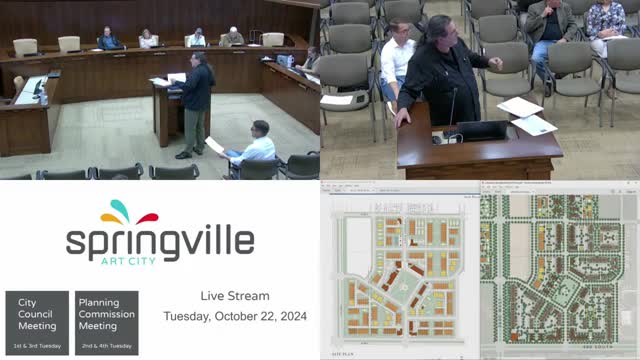Developers propose lower density plan for Lakeside Landing emphasizing owner-occupied homes
November 16, 2024 | Springville City Council, Springville, Utah County, Utah
This article was created by AI summarizing key points discussed. AI makes mistakes, so for full details and context, please refer to the video of the full meeting. Please report any errors so we can fix them. Report an error »

The Springville City Council meeting on November 16, 2024, focused on a significant proposal regarding the development of Lakeside Landing, which aims to shift from a high-density apartment complex to a more diverse community of owner-occupied homes and reduced rental units.
The discussion highlighted the differences between apartment buildings and owner-occupied townhomes, emphasizing the importance of street engagement and community life. The proposed plan reduces the number of rental apartments from 427 to just 46, while increasing the number of owner-occupied homes to 262. This shift is intended to create a more vibrant community with increased green space, rising from 50,000 square feet to 250,000 square feet.
Ed Axelley, President of the Utah Builders Association, presented the rationale behind the changes, noting a current surplus of apartments and commercial space in the market. He argued that the new design would foster a more successful community by prioritizing homeownership and reducing the number of cars, while still maintaining a walkable environment with commercial spaces along Main Street.
The proposal also aims to enhance community diversity, particularly among families, as studies indicate that owner-occupied homes tend to attract more children compared to apartments. Axelley pointed out that the average household income in owner-occupied units is significantly higher than that in rental apartments, suggesting that this shift could lead to increased local spending and economic benefits for Springville.
The council members expressed concerns about the potential risks of the new plan, particularly regarding the viability of commercial spaces. However, Axelley reassured them that the design allows for flexibility and adaptation as the community evolves.
In conclusion, the proposed development at Lakeside Landing represents a strategic pivot towards creating a more sustainable and engaging community in Springville, with a focus on homeownership, green spaces, and economic vitality. The council will continue to evaluate the proposal and its implications for the future of the city.
The discussion highlighted the differences between apartment buildings and owner-occupied townhomes, emphasizing the importance of street engagement and community life. The proposed plan reduces the number of rental apartments from 427 to just 46, while increasing the number of owner-occupied homes to 262. This shift is intended to create a more vibrant community with increased green space, rising from 50,000 square feet to 250,000 square feet.
Ed Axelley, President of the Utah Builders Association, presented the rationale behind the changes, noting a current surplus of apartments and commercial space in the market. He argued that the new design would foster a more successful community by prioritizing homeownership and reducing the number of cars, while still maintaining a walkable environment with commercial spaces along Main Street.
The proposal also aims to enhance community diversity, particularly among families, as studies indicate that owner-occupied homes tend to attract more children compared to apartments. Axelley pointed out that the average household income in owner-occupied units is significantly higher than that in rental apartments, suggesting that this shift could lead to increased local spending and economic benefits for Springville.
The council members expressed concerns about the potential risks of the new plan, particularly regarding the viability of commercial spaces. However, Axelley reassured them that the design allows for flexibility and adaptation as the community evolves.
In conclusion, the proposed development at Lakeside Landing represents a strategic pivot towards creating a more sustainable and engaging community in Springville, with a focus on homeownership, green spaces, and economic vitality. The council will continue to evaluate the proposal and its implications for the future of the city.
View full meeting
This article is based on a recent meeting—watch the full video and explore the complete transcript for deeper insights into the discussion.
View full meeting

